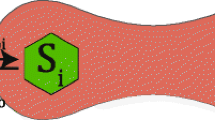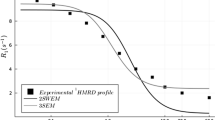Abstract
The 13C NMR spectrum of 13C-urea in a suspension of human red cells of reduced mean cell volume was observed to contain partially resolved resonances arising from the intra- and extracellular populations of the compound. It was shown that at 25°C and a magnetic field strength of 9.4 T, the rate of exchange of urea between the intra- and extracellular populations was such that the NMR lineshape was sensitive to a change in the rate of 13C-urea exchange, induced either by the addition of the urea transport inhibitor phloretin, or by the addition of 12C-urea. Total lineshape analysis of r3C NMR spectra of 13C-urea in red cell suspensions containing different concentrations of 12C-urea resulted in a weighted mean estimate for the Km and Vmax for urea equilibrium exchange from three experiments of 44 ± 18 mM and 3.1 ± 0.6 × 10−8 molcm−2 s−1, respectively (the errors denote the weighted mean standard deviations). These estimates of Km and Vmax, were significantly lower than previous values reported in the literature and determined using other techniques.
Similar content being viewed by others
References
Akitt JW (1983) NMR and chemistry: An introduction to the Fourier transform-multinuclear era. 2nd ed., Chapman and Hall, London
Alger JR, Prestegard JH (1979) Nuclear magnetic resonance studies of acetic acid permeation of large unilamellar vesicle membranes. Biophys J 28:1–14
Brahm J (1983) Urea permeability of human red cells. J Gen Physiol 82:1–23
Bubb WA, Kirk K, Kuchel PW (1988) Ethylene glycol as an x-nucleus thermometer for biological samples. J Magn Reson 77:363–368
Dacie JV, Lewis SM (1975) Practical haematology, 5th edn, p 12, Churchill Livingstone, London
Dwek RA (1973) Nuclear magnetic resonance in biochemistry: Application to enzyme systems. Clarendon, Oxford, pp 37–40
Fabry ME, San George RC (1983) Effect of magnetic susceptibility on nuclear magnetic resonance signals arising from red cells: a warning. Biochemistry 22:4119–4125
Farrar TC, Becker ED (1971) Pulse and Fourier transform NMR: Introduction to theory and methods, Academic Press, New York, pp 20–22
Fröhlich O, Macey RI, Edwards-Moulds J, Gargus JJ, Gunn RB (1991) Urea transport deficiency in Jk(a-b-) erythrocytes. Amer J Physiol 260:C778-C783
Hoffman DW, Henkens RW (1987) The rates of fast reactions of carbon dioxide and bicarbonate in human erythrocytes measures by carbon-13 NMR. Biochem Biophys Res Commun 143:67–73
Hunter FR (1970) Facilitated diffusion in human erythrocytes. Biochim Biophys Acta 211:216–222
Karan DM, Macey RI (1990) Temperature- and concentration-dependence of urea permeability of human erythrocytes determined by NMR. Biochim Biophys Acta 1024:271–277
Kirk K, Kuchel PW (1985) Red cell volume changes monitored using a new 31P NMR procedure. J Magn Reson 62:568–572
Kirk K, Kuchel PW (1986) Equilibrium exchange of dimethyl methylphosphonate across the human red cell membrane measured using NMR spin transfer. J Magn Reson 68:311–318
Kirk K, Kuchel PW (1988a) Characterization of transmembrane chemical shift differences in the 31P NMR spectra of various phosphoryl compounds added to erythrocyte suspensions. Biochemistry 27:8795–8802
Kirk K, Kuchel PW (1988b) Physical basis of the effect of hemoglobin on the 31P NMR chemical shifts of various phosphoryl compounds. Biochemistry 27:8803–8810
Kirk K, Kuchel PW, Labotka RJ (1988) Hypophosphite ion as a 31p nuclear magnetic resonance probe of membrane potential in erythrocyte suspensions. Biophys J 54:241–247
Lehman H, Huntsman RG (1966) Man's haemoglobins, p. 35, NorthHolland, Amsterdam
Macey RI (1984) Transport of water and urea in red blood cells. Am J Physiol 246:C195-C203
Macey RI, Farmer REL (1970) Inhibition of water and solute permeability in human red cells. Biochim Biophys Acta 211:104–106
Macey RI, Yousef LW (1988) Osmotic stability of red cells in renal circulation requires rapid urea transport. Am J Physiol 254:C669-C674
Maciel GE, Natterstad JJ (1965) Carbon-13 chemical shifts of the carbonyl group. III. Solvent effects. J Chem Phys 42:2752–2759
Mayrand RR, Levitt DG (1983) Urea and ethylene gycol-facilitated transport systems in the human red cell membrane. J Gen Physiol 81:221–237
Naccache P, Sha'afi RI (1974) Effect of pCMBS on water transfer across biological membranes. J Cell Physiol 83:449–456
Ojcius DM, Solomon AK (1988) Sites of p-chloromercuribenzene-sulfonate inhibition of red cell urea and water transport. Biochim Biophys Acta 942:73–82
Oki M (1985) Applications of dynamic NMR spectroscopy to organic chemistry. VCH, Deerfield Beach, FL, pp 1–37
Osborne MR (1976) Non-linear least squares — the Levenberg algorithm revisited. J Aust Math Soc B 19:343–357
Philo JS, Dreyer U, Schuster TM (1984) Diamagnetism of human apo-, oxy-, and (carbonmonoxy)hemoglobin. Biochemistry 23:865–872
Pirkle JL, Ashley DL, Goldstein JH (1979) Pulse magnetic resonance measurements of water exchange across the erythrocyte membrane employing low Mn concentration. Biophys J 25:389–406
Rogers MT, Woodbrey JC (1962) A proton magnetic resonance study of hindered internal rotation in some substituted N,N-dimethylamides. J Phys Chem 66:540–546
Sandström J (1982) Dynamic NMR spectroscopy. Academic Press, New York
Savitz D, Sidel VW, Solomon AK (1964) Osmotic properties of human red cells. J Gen Physiol 48:79–94
Toon MR, Solomon AK (1985) Relation between red cell anion exchange and urea transport. Biochim Biophys Acta 821:502–504
Toon MR, Solomon AK (1986) Control of red cell urea and water permeability by sulphydryl reagents. Biochim Biophys Acta 860:361–375
Xu AS-L, Potts JR, Kuchel PW (1991) The phenomenon of separate intra- and extracellular resonances of difluorophosphate in 31p and 19F NMR spectra of erythrocytes. Magn Reson Med 18:193–198
Yousef LW Macey RI (1989) A method to distinguish between pore and carrier kinetics applied to urea transport across the erythrocyte membrane. Biochim Biophys Acta 984:281–288
Author information
Authors and Affiliations
Additional information
Correspondence to: P. W Kuchel
Rights and permissions
About this article
Cite this article
Potts, J.R., Bulliman, B.T. & Kuchel, P.W. Urea exchange across the human erythrocyte membrane measured using 13C NMR lineshape analysis. Eur Biophys J 21, 207–216 (1992). https://doi.org/10.1007/BF00196765
Received:
Accepted:
Issue Date:
DOI: https://doi.org/10.1007/BF00196765




